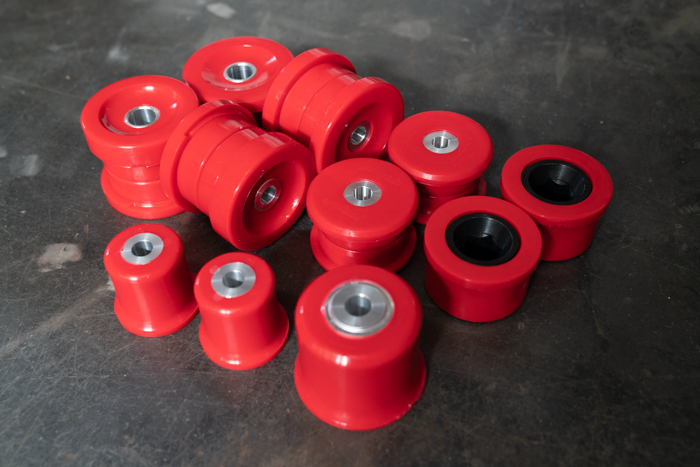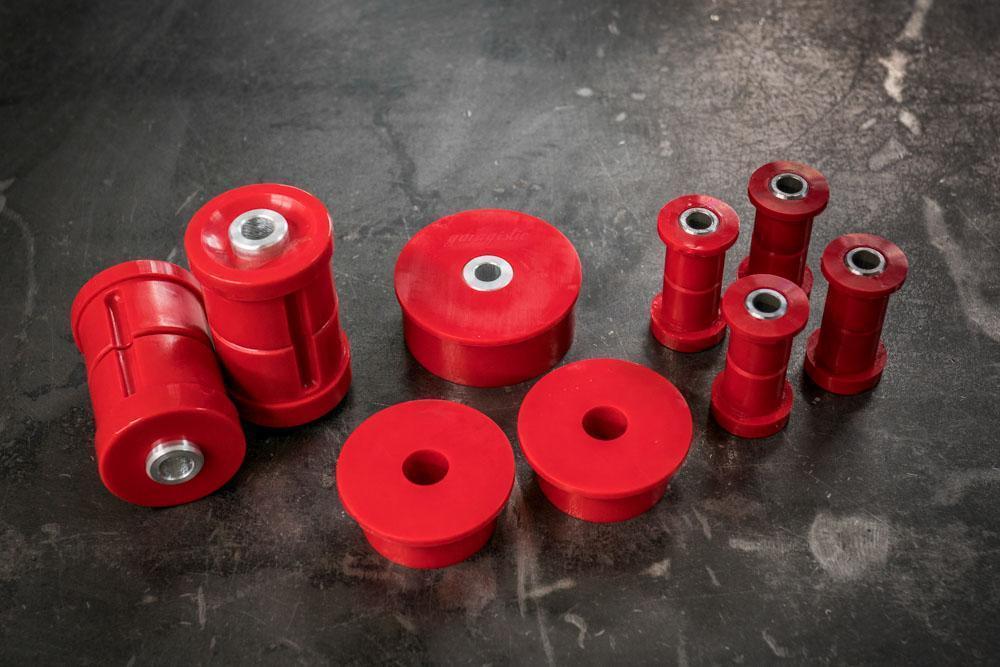Polyurethane and rubber bushings, both essential components in automotive suspension systems, offer distinct advantages and trade-offs in terms of performance, durability, and ride comfort. While rubber bushings provide a smoother, quieter ride, polyurethane bushings are known for their enhanced durability, improved handling, and resistance to chemicals and wear.
Chemical Resistance in Harsh Environments
Polyurethane bushings excel in harsh environments due to their exceptional chemical resistance, making them ideal for applications where exposure to various substances is common.
- Polyurethane bushingsmaintain their integrity when exposed to oils, chemicals, ozone, and UV radiation.
- They exhibit high resistance to solvents, which can degrade rubber bushings over time.
- The material’s resistance to oxygen and ozone exposure helps prevent premature aging and deterioration.
This chemical resistance enhances durability in automotive applications, especially in areas prone to contamination from road debris, engine fluids, and environmental factors. For example, suspension systems near the engine bay or undercarriage benefit from polyurethane’s ability to resist degradation caused by motor oil, coolant, or fuel vapors.
While polyurethane shows excellent resistance to aliphatic hydrocarbons, organic solvents, weak acids, bases, ozone, and oxidation, some strong acids, bases, or specific solvents can still affect it. Manufacturers provide chemical compatibility charts to guide proper selection for specific applications.
Longevity and Durability Comparison
Polyurethane consistently outperforms rubber in terms of lifespan and wear resistance, making it a popular choice for vehicle owners and manufacturers prioritizing long-term performance.
Characteristic
Polyurethane Bushings
Rubber Bushings
Lifespan
Can last the vehicle’s lifetime
Typically last about 15 years
Wear Resistance
Exceptional, maintains performance without degradation
Prone to cracking and degradation over time
Maintenance
Often described as “fit and forget” products
May require more frequent replacement
Environmental Resistance
Highly resistant to oils, chemicals, ozone, and UV radiation
More susceptible to environmental factors
Polyurethane’s molecular structure resists compression set, allowing it to retain shape under stress and withstand repeated compression and expansion cycles. Rubber, though effective initially, softens and deforms over time, especially when exposed to heat, oils, and environmental contaminants.
Polyurethane bushings are particularly advantageous in high-stress applications, such as off-road vehicles or heavy-duty machinery, where their durability reduces maintenance needs. However, their increased stiffness can result in a firmer ride and more noise transmission compared to rubber bushings, which should be considered for daily driving vehicles.
Impact on Vehicle Handling
Polyurethane bushings significantly enhance vehicle handling by offering improved steering response and reduced body roll. Their stiffness allows precise control of suspension geometry, leading to:
- Better traction and road feel due to rigidity.
- Reduced unwanted suspension movement, maintaining proper wheel alignment during cornering.
- Enhanced stability, especially for performance-oriented driving and track use.
However, this improved handling comes at the cost of a firmer ride and increased noise, vibration, and harshness (NVH) levels, which some drivers may find less comfortable for daily use. A hybrid approach—using polyurethane bushings in performance-critical locations and rubber bushings in areas affecting comfort—can provide a balanced solution.
Temperature Extremes and Material Performance
Polyurethane bushings perform well across a wide temperature range, making them suitable for extreme climates.
- Polyurethane retains its elasticity and shape at high temperatures, unlike rubber, which softens and deforms.
- At low temperatures, polyurethane remains flexible, while rubber hardens and becomes brittle.
Polyurethane generally functions from -62°C to 93°C (-80°F to 200°F), with special formulations extending this range to 150°C (300°F). This temperature resilience ensures consistent performance and reduces maintenance needs, particularly in environments with fluctuating climates.
Corrosion Resistance in Industrial Settings
Polyurethane bushings outperform rubber and metal alternatives in terms of corrosion resistance.
- Resistant to oils, solvents, and industrial chemicals.
- Effective in saltwater environments, suitable for marine applications.
- Non-conductive, protecting against galvanic corrosion in metal-to-metal contact points.
These properties make polyurethane bushings ideal for industrial applications, such as chemical processing plants and offshore platforms, where they can significantly outlast traditional materials.
Fatigue Resistance Over Time
Polyurethane bushings offer superior fatigue resistance, maintaining performance over extended periods of cyclic loading.
- Withstand millions of flex cycles without significant degradation.
- Retain shape and elasticity even after prolonged use, unlike rubber, which compresses and deforms permanently.
In automotive applications, this translates to consistent handling and ride quality over time. For industrial machinery, it means reduced maintenance intervals and improved equipment reliability.
Vibration Dampening Capabilities
Polyurethane bushings provide excellent vibration dampening capabilities.
- Can be engineered with specific damping characteristics for various applications.
- Maintain vibration dampening properties over a wider range of frequencies than rubber.
- Absorb vibrations effectively, reducing fatigue on connected components and extending their lifespan.
In automotive systems, polyurethane bushings strike a balance between ride comfort and handling precision. While they may transmit more road feel than rubber bushings, they effectively dampen high-frequency vibrations.
Summary
Polyurethane and rubber bushings each serve vital roles in automotive and industrial applications. Rubber bushings prioritize comfort, offering a smoother and quieter ride, but are prone to wear over time. Polyurethane bushings, while stiffer and potentially noisier, excel in durability, chemical resistance, and performance under extreme conditions.
For performance-oriented drivers or applications in harsh environments, polyurethane bushings provide long-term reliability and enhanced handling. Conversely, rubber bushings remain a preferred choice for those prioritizing ride comfort and quiet operation. Choosing the right material depends on the application, environment, and individual preferences, with a hybrid approach often offering the best of both worlds.





